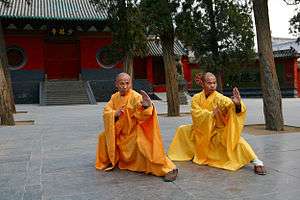T'ai chi classics
| Part of a series on |
| Chinese martial arts (Wushu) |
|---|
 |
|
Styles of Chinese martial arts
|
| Wushu in the world |
|
Historical locations Chen Village (陳家溝) |
| Wushu athletes/practitioners |
|
Legendary figures Bodhidharma (菩提達摩) |
|
Historical individuals Yue Fei (岳飛; 1103—1142) |
|
Modern celebrities Bruce Lee (李小龍 1940—1973) |
| Wushu influence |
|
Related |
The T'ai chi classics are classical texts used as guides for the practice of the Chinese martial art of t'ai chi ch'uan. These texts, which vary from school to school, are usually written in classical Chinese and are used by modern schools that trace their lineage from the Chen family or from them through the Yang family.[1][2]
While great antiquity is usually claimed for texts by legendary authors, modern scholarship has not been able to date any of them earlier than the late 19th century.[2]
Writings accorded Classic status
- T'ai Chi Ch'uan Classic (Chinese: 太極拳經; pinyin: Tàijíquán Jīng; Wade–Giles: T'ai Chi Ch'uan Ching) attributed to the legendary founder of t'ai chi ch'uan, Zhang Sanfeng, claimed to be ca. 12th-14th century.[3]
- Salt Shop Manual (Chinese: 鹽店譜; pinyin: Yán Diàn Pǔ) containing the T'ai Chi Ch'uan Treatise (Chinese: 太極拳論; pinyin: Tàijíquán Lùn; Wade–Giles: T'ai Chi Ch'uan Lun) attributed to the legendary Wang Tsung-yueh (Wang Zongyue). The text was said to have been found stored in the back room of a Beijing salt shop by Wu Yu-hsiang's brother Wu Ch'eng-ch'ing.[2][3][4]
- Miscellaneous texts: Song of Thirteen Postures, Mental Elucidation of the Practise of T'ai Chi Ch'uan and the Song of Sparring handed down in the Yang and Wu families.[3]
- Texts by Wu Yu-hsiang (Wu Yuxiang), a central figure in Wu (Hao)-style t'ai chi ch'uan, and his relatives; especially his nephew Li I-yü (Chinese: 李亦畬; pinyin: Li Yiyu; 1832-1892).[2]
- Forty Chapters of writings, with the last three chapters directly attributed to Chang San-feng, preserved in the Yang and Wu Chien-ch'uan families.[2][5]
- T'ai Chi Ch'uan Illustrated (Chinese: 太極拳圖說; pinyin: Tàijíquán Túshuō) published in 1919 by Ch'en Hsin (Chinese: 陳鑫; pinyin: Chen Xin; 1849-1929) an important Chen family scholar.[2]
- The Study of T'ai Chi Ch'uan (Chinese: 太極拳學; pinyin: Tàijíquán Xué) first published in 1924 by Sun Lu-t'ang, the founder of the fifth and last classical style of t'ai chi ch'uan.[2]
- Yang Chengfu (1883-1936) published his Complete Principles and Applications of T'ai Chi Ch'uan in 1934, a work considered authoritative in schools influenced by his many students and progeny. The book includes the well known "Ten Essential Points of Taijiquan Theory" authored by Ch'eng-fu.[3][6]
- Wu Kung-tsao (Wu Gongzao; 1902-1983) provided original texts and commentary on the previously mentioned Forty Chapters in Wu Family T'ai Chi Ch'uan.[7] Wu's grandfather Wu Ch'uan-yu (Wu Quanyou) had inherited the Forty Chapters from Yang Pan-hou. The book was first published in Changsha in 1935. In 1980, when the book was published again in Hong Kong, the famous wuxia author Jin Yong contributed a postscript to Wu Kung-tsao's text in which Jin described influences from as far back as Lao Tzu and Chuang Tzu on contemporary Chinese martial arts.[2][5]
Collections, Translations, and Studies
| Wikiquote has quotations related to: Tai chi chuan |
- Davis, Barbara, "The Taijiquan Classics: An Annotated Translation" (Berkeley: North Atlantic, 2004)
- Jou, Tsung-hwa, "The Tao of T'ai Chi Ch'uan" (Rutland: Tuttle, 1980)
- Liang, T.T., "T'ai Chi Ch'uan for Health and Self-Defense:Philosophy and Practice (New York: VIntage, 1977)
- Lo, Benjamin; Inn, Martin; Amacker, Robert; Foe, Susan - "The Essence of T'ai Chi Ch'uan: The Literary Tradition" (Berkeley: North Atlantic, 1979 ISBN 0913028630)
- Wile, Doug, "Tai Chi Touchstones: Yang Family Secret Transmissions" (Sweet Ch'i Press 1983)
- Wile, Doug, "Lost T'ai-chi Classics from the Late Ch'ing Dynasty" (Albany: SUNY, 1996)
- Xin, Chen, "The Illustrated Canon of Chen Family Taijiquan" (Xi'an: INBI Matrix, 2007)
References
- ↑ Liao, Waysun (1990) [1977]. T'ai Chi Classics. Boston: Shambhala Publications. pp. VIII. ISBN 0-87773-531-X.
- 1 2 3 4 5 6 7 8 Wile, Douglas (1995). Lost T'ai-chi Classics from the Late Ch'ing Dynasty (Chinese Philosophy and Culture). State University of New York Press. ISBN 978-0-7914-2654-8.
- 1 2 3 4 Wile, Douglas (1983). Tai Chi Touchstones: Yang Family Secret Transmissions. Sweet Ch'i Press. ISBN 978-0-912059-01-3.
- ↑ Horwitz, Kimmelman, Lui (1976). T'ai chi ch'uan: The Technique of Power. Chicago Review Press. ISBN 0-914090-49-6.
- 1 2 Wu, Kung-tsao (2006) [1980]. Wu Family T'ai Chi Ch'uan (吳家太極拳). Chien-ch’uan T’ai-chi Ch’uan Association. ISBN 0-9780499-0-X.
- ↑ Fu, Zhongwen (2006) [1996]. Mastering Yang Style Taijiquan. Louis Swaim. Berkeley, California: Blue Snake Books. ISBN 1-58394-152-5.
- ↑ Philip-Simpson, Margaret (June 1995). "A Look at Wu Style Teaching Methods - T'AI CHI The International Magazine of T'ai Chi Ch'uan Vol. 19 No. 3". Wayfarer Publications. ISSN 0730-1049.